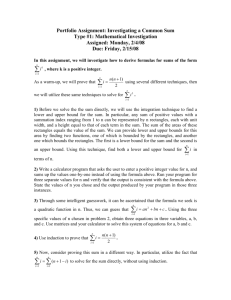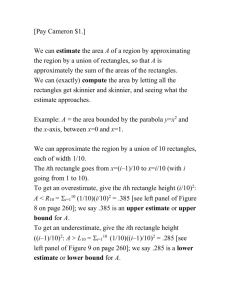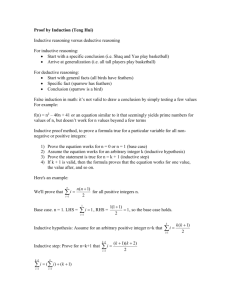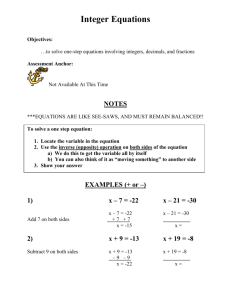Portfolio Assignment: Mathematical Modeling
advertisement
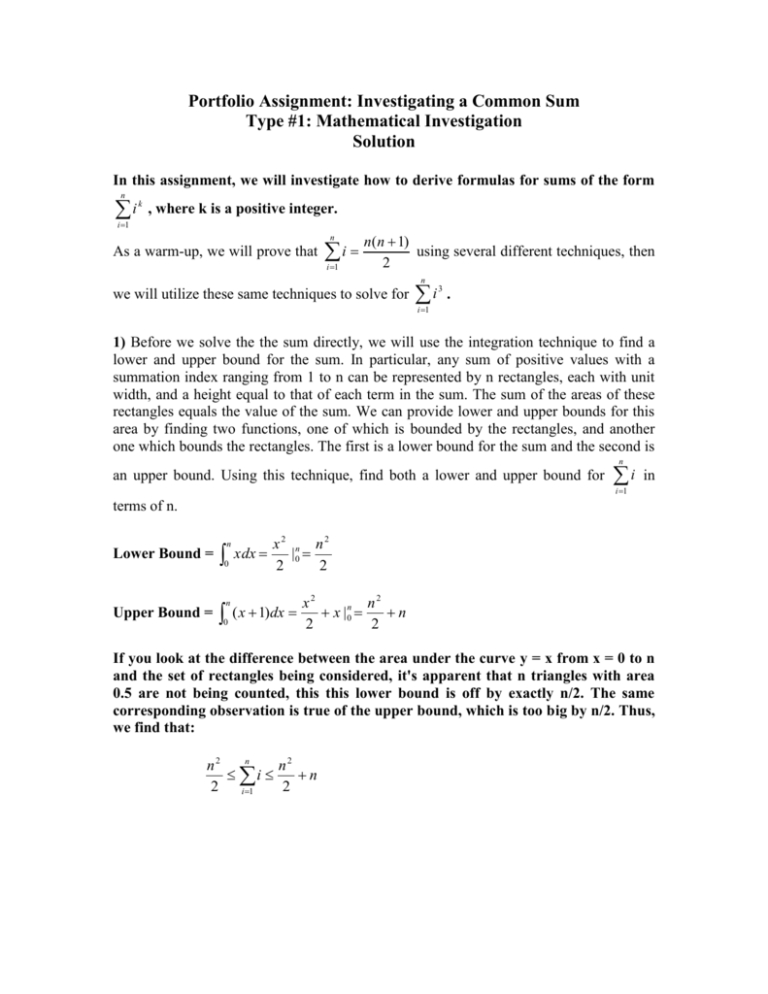
Portfolio Assignment: Investigating a Common Sum Type #1: Mathematical Investigation Solution In this assignment, we will investigate how to derive formulas for sums of the form n i k , where k is a positive integer. i 1 n As a warm-up, we will prove that i i 1 n(n 1) using several different techniques, then 2 n we will utilize these same techniques to solve for i 3 . i 1 1) Before we solve the the sum directly, we will use the integration technique to find a lower and upper bound for the sum. In particular, any sum of positive values with a summation index ranging from 1 to n can be represented by n rectangles, each with unit width, and a height equal to that of each term in the sum. The sum of the areas of these rectangles equals the value of the sum. We can provide lower and upper bounds for this area by finding two functions, one of which is bounded by the rectangles, and another one which bounds the rectangles. The first is a lower bound for the sum and the second is n an upper bound. Using this technique, find both a lower and upper bound for i in i 1 terms of n. Lower Bound = n 0 xdx x2 n n2 |0 2 2 x2 n2 n x |0 n Upper Bound = ( x 1)dx 0 2 2 n If you look at the difference between the area under the curve y = x from x = 0 to n and the set of rectangles being considered, it's apparent that n triangles with area 0.5 are not being counted, this this lower bound is off by exactly n/2. The same corresponding observation is true of the upper bound, which is too big by n/2. Thus, we find that: n n2 n2 i n 2 2 i 1 2) Write a calculator program that asks the user to enter a positive integer value for n, and sums up the values one-by-one instead of using the formula above. Run your program for three separate values for n and verify that the output is consistent with the formula above. State the values of n you chose and the output produced by your program in those three instances. Here is the code from the calculator program: Prompt N 0 → S For(I,1,N,1) S + I → S End Disp S End For n = 5, the output was 15 For n = 10, the output was 55. For n = 20, the output was 210. 3) Through some intelligent guesswork, it can be ascertained that the formula we seek is n a quadratic function in n. Thus, we can guess that i an 2 bn c . Using the three i 1 specific values of n chosen in problem 2, obtain three equations in three variables, a, b, and c. Use matrices and your calculator to solve this system of equations for a, b and c. Using the values of the sum from question #2, here are the three equations obtained: 15 = 25a + 5b + c 55 = 100a + 10b + c 210 = 400a + 20b + c The solution to this system can be expressed as the solution to the following matrix equation: 25 5 1 a 15 100 10 1 b 55 400 20 1 c 210 a 25 5 1 b 100 10 1 c 400 20 1 1 1 15 2 55 1 , using a graphic calculator. 2 210 0 n 4) Use induction to prove that i i 1 n(n 1) . 2 1 Base case n = 1: LHS = i 1 , RHS = i 1 1(1 1) 1 2 Inductive hypothesis: Assume for an arbitrary positive integer value of n=k that k k (k 1) i . 2 i 1 k 1 Inductive step: Prove for n=k+1 that i i 1 k 1 (k 1)( k 2) 2 k i i (k 1) i 1 i 1 k (k 1) (k 1) , using the inductive hypothesis 2 k (k 1) 2(k 1) 2 2 (k 1)( k 2) , proving the inductive hypothesis. 2 n Thus, for all positive integers n, i i 1 n(n 1) . 2 5) Now, consider proving this sum in a different way. In particular, utilize the fact that n n i 1 i 1 i (n 1 i) to solve for the sum directly, without using induction. Let S = n n i 1 i 1 i (n 1 i) . It follows that 2S = n n n n i 1 i 1 i 1 i 1 i (n 1 i) (i n 1 i) (n 1) n(n 1) . n Dividing both sides of this equation by 2, we find that S = i i 1 n(n 1) . 2 6) Next, prove this sum utilizing the pertubation method. In particular, utilize the fact that n n i 1 i 1 (i 1) 2 i 2 (n 1) 2 12 . This fact is derived from noting that all the terms in the two sums are the same except that the first sum contains (n+1)2 while the second one does not, and the second one contains 12, while the first one does not. In order to n complete the proof, assume that the sum 1 n , is known. (In general, when using this i 1 n method, it will be assumed that all the sums of the form i k are known for values of k i 1 lower than the exponent for which the sum is being solved.) n n i 1 i 1 (i 1) 2 i 2 (n 1) 2 12 n (i 2 2i 1 i 2 ) (n 1) 2 1 i 1 n (2i 1) (n 1) 2 1 i 1 n n 2 i 1 n 2 2 n 1 1 i 1 i 1 n ( 2 i ) n n 2 2 n i 1 n ( 2 i ) n 2 n i 1 n 2 n n(n 1) i 2 2 i 1 n n 7) Apply the integration technique to find lower and upper bounds for the sum i 3 . Can i 1 n you generalize this work to quickly find lower and upper bounds for general sum i i 1 If so, what are these bounds? Lower Bound = Upper Bound = n 0 n 0 x 3 dx x4 n n4 |0 4 4 ( x 1) 3 dx ( x 1) 4 n (n 1) 4 |0 4 4 k ? Thus, we find that n n4 (n 1) 4 . i3 4 4 i 1 In general, we obtain that n n k 1 (n 1) k 1 . i k k 1 i 1 k 1 8) Write a calculator program that asks the user to enter a positive integer value for n, and sums up the values one-by-one instead of using the formula above. Run your program for five separate values for n and state the values of n you chose and the output produced by your program in those instances. Here's the program: Prompt N 0 → S For(I,1,N,1) S + I*I*I → S End Disp S End For n = 1, the output was 1 For n = 2, the output was 9. For n = 3, the output was 36. For n = 4, the output was 100. For n = 5, the output was 225. n 9) Assuming that i 3 an 4 bn 3 cn 2 dn e , for some constants a, b, c, d, and e, i 1 use the five values you got in question 8 to create five equations and these five variables. n Solve this system using matrices and your calculator. Thus, give a formula for i i 1 Here are the five equations: 1=a+b+c+d+e 9 = 16a + 8b + 4c + 2d + e 36 = 81a + 27b + 9c + 3d + e 100 = 256a + 64b + 16c + 4d + e 225 = 625a + 125b + 25c + 5d + e 3 . In matrix form, we have: 1 1 1 1 16 8 4 2 81 27 9 3 256 64 16 4 625 125 25 5 1 a 1 1 b 9 1 c 36 1 d 100 1 e 225 1 1 1 a 1 b 16 8 4 2 c 81 27 9 3 d 256 64 16 4 e 625 125 25 5 1 1 1 1 1 1 1 9 36 100 225 a 0.25 b 0 .5 c 0.25 d 0 e 0 n 10) Now that you have a good idea of what i 3 , use induction to verify your work from i 1 question 9. n Use induction to prove that i i 1 1 Base case n = 1: LHS = i i 1 3 3 1 4 1 3 1 2 n n n . 4 2 4 1 , RHS = 1 1 1 1 4 2 4 Inductive hypothesis: Assume for an arbitrary positive integer value of n=k that k 1 1 1 i3 k 4 k 3 k 2 . 4 2 4 i 1 k 1 Inductive step: Prove for n=k+1 that i 3 i 1 k 1 k i 1 i 1 1 1 1 (k 1) 4 (k 1) 3 (k 1) 2 4 2 4 i 3 i 3 (k 1) 3 1 4 1 3 1 2 k k k (k 1) 3 , using the inductive hypothesis. 4 2 4 k 2 (k 1) 2 (k 1) 3 4 2 k (k 1) 2 4(k 1) 3 4 2 2 (k 1) (k 4(k 1)) 4 2 2 (k 1) (k 4k 4) 4 2 (k 1) (k 2) 2 4 1 1 1 (k 1) 4 (k 1) 3 (k 1) 2 , proving the inductive hypothesis. 4 2 4 11) What types of generalizations and conclusions can you draw about calculating n closed-form formulas for sums of the form i k , for positive integer values of k? i 1 Using the upper and lower bounds in the integration technique, we find that n 1 i k will always be a polynomial of degree k+1, with the leading coefficient . k 1 i 1 One other interesting pattern is the coefficient to the second to largest term always seems to be 0.5. There is nothing in our previous work to prove this claim however. We have observed that it's true for k=1,2 and 3. To solve for the other coefficients, several techniques exist, all of which quickly get more tedious for larger and larger values of k. Using the system of equations technique, for each larger value of k, there is one more unknown variable to solve for, thus, one more data point has to be added for each larger value of k. Using the pertubation method, one must utilize all of the previous formulas to derive the following one. Finally, induction is ONLY useful on its own when one knows what the final result will be. Without that knowledge, one can not even set up the inductive proof. 12) For extra credit, use the pertubation method to derive the sum. (Note: This is very, very tedious, so don't feel obligated to do this. Also, if you don't do it, it won't count against your IB score for this assignment.) In order to use this method, you must use the n n n(n 1) n 2 n(n 1)( 2n 1) n 2 (n 1) 2 following formulas: i , i , and i 3 . 2 6 4 i 1 i 1 i 1 n n i 1 i 1 (i 1) 4 i 4 (n 1) 4 14 n (4i 3 6i 2 4i 1) n 4 4n 3 6n 2 4n i 1 n ( 4i 3 ) i 1 6n(n 1)( 2n 1) 4n(n 1) n n 4 4n 3 6n 2 4n 6 2 n ( 4i 3 ) n(n 1)( 2n 1) 2n(n 1) n n 4 4n 3 6n 2 4n i 1 n ( 4i 3 ) 2n 3 3n 2 n 2n 2 2n n n 4 4n 3 6n 2 4n i 1 n ( 4i 3 ) n 4 2n 3 n 2 i 1 n 4 2n 3 n 2 4 i 1 2 n n (n 1) 2 3 i 4 i 1 n i3
